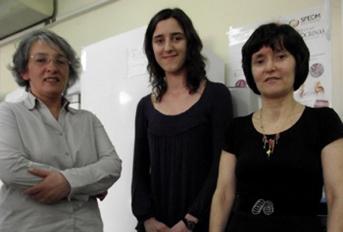Associação Portuguesa de Investigação em Cancro
Genetic alterations in thyroid tumours from patients irradiated in childhood for tinea capitis
Genetic alterations in thyroid tumours from patients irradiated in childhood for tinea capitis

X-ray scalp epilation for tinea capitis (scalp ringworm) treatment was used in 1950-1960. The study of individuals submitted to this therapeutic approach has shown an increase head and neck tumours prevalence, namely thyroid cancer. As we had access to a cohort of individuals submitted to this treatment in the North of Portugal, we searched for the more frequent thyroid tumours mutations (BRAF, NRAS and RET/PTC rearrangement), in a subgroup of individuals from the original cohort that developed these tumours. Our results have shown that the prevalence of BRAFV600E mutation in our series is the highest reported in series of papillary thyroid carcinomas arising in radiation exposed individuals.
Authors and affiliations:
Paula Boaventura1, Dina Pereira1, Ricardo Celestino1, Adélia Mendes1, Tadao Nakasawa1,2, José Teixeira-Gomes1, Manuel Sobrinho-Simões1,3,4, Paula Soares1,3,
1 - IPATIMUP - Institute of Molecular Pathology and Immunology of the University of Porto, Portugal
2 - Department of Pathology, Interdisciplinary Graduate School of Medicine and Engineering, University of Yamanashi, Yamanashi, Japan
3 - Department of Pathology and Oncology, Medical Faculty, University of Porto, Portugal
4 – Department of Pathology, Hospital Centre of S. João, Porto, Portugal
Abstract:
Objective - Exposure to ionizing radiation at young age is the strongest risk factor for the occurrence of papillary thyroid carcinoma (PTC). RET/PTC rearrangements are the most frequent genetic alterations associated with radiation-induced PTC, whereas BRAF and RAS mutations and PAX8-PPARG rearrangement have been associated with sporadic PTC. We decided to search for such genetic alterations in PTCs of patients subjected in the childhood to scalp irradiation.
Design - We studied 67 thyroid tumours from 49 individuals irradiated in childhood for tinea capitis scalp epilation: 36 malignant (12 cases of conventional PTC – cPTC, 2 cPTC metastases, 20 cases of follicular variant PTC – FVPTC, one oncocytic variant of PTC and one follicular carcinoma) and 31 follicular adenomas (FTA).
Methods - The lesions were screened for the BRAFV600E and NRAS mutations and for RET/PTC and PAX8-PPARG rearrangements.
Results – BRAFV600E mutation was detected in 7 out of 14 (50%) cPTC and 2 out of 20 FVPTC (10%) (p=0.019). NRAS mutation was present in one case of FVPTC (5%). RET/PTC1 rearrangement was found, by RT-PCR, in one out of 17 cases (5.9%) and by FISH in 2 out of 6 cases (33%). PAX8-PPARG rearrangement was not detected in any carcinoma. None of the follicular adenomas presented any of the aforementioned genetic alterations.
Conclusions – The prevalence of BRAFV600E mutation in our series is the highest reported in series of PTCs arising in radiation exposed individuals. The prevalence of RET/PTC1 rearrangement fits with the values recently described in a similar setting.
Journal:
European Journal of Endocrinology
Link:
http://eje-online.org/content/early/2013/08/21/EJE-13-0543.abstract




